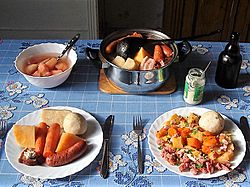Steckrübeneintopf facts for kids
 |
|
| Type | Soup |
|---|---|
| Place of origin | Germany |
| Main ingredients | Rutabaga, carrots, potatoes, smoked or pickled meats or sausages |
Steckrübeneintopf is a traditional German dish. It is a type of stew that is very popular in North Germany. This hearty meal is made mostly from rutabaga (also called swede), carrots, and potatoes.
It also includes different kinds of meat or sausage, often smoked or pickled. Sometimes, special cooking pears are added too. People season Steckrübeneintopf with salt, pepper, mustard, horseradish, celery, leeks, or parsley. They add these to make it taste just right for them.
What is Steckrübeneintopf Made Of?
The main ingredients of Steckrübeneintopf are root vegetables. These include rutabaga, carrots, and potatoes. Rutabaga is a vegetable that looks a bit like a large turnip. It has a slightly sweet and earthy taste.
The meat in the stew can be smoked or pickled. This gives the dish a rich, savory flavor. Sometimes, people add special cooking pears. These pears are not eaten raw; they become soft and sweet when cooked in the stew.
Regional Differences in Germany
Steckrübeneintopf has been a common meal on many farms in Germany for a long time. It was often eaten almost every day, sometimes alternating with other dishes.
In the Schleswig-Holstein region, this stew is called Rübenmalheur. Here, it is often made with pre-cooked sausage (called Kochwurst) and Kassler (a type of smoked pork).
In Lübeck, a city in northern Germany, a version called Lübecker National is popular. This recipe often uses pork from the blade or belly. It can also include onions for extra flavor. The city of Hamburg has a similar dish known as Hamburger National.
In an area called Land Hadeln, people often use white flour dumplings instead of potatoes. These dumplings are called Klüten. Because of this, the dish is known as Speck und Klüten, which means "bacon and dumplings." This version was once a very popular and filling meal for Christmas Eve dinner.
See also
 In Spanish: Steckrübeneintopf para niños
In Spanish: Steckrübeneintopf para niños

